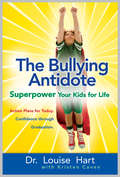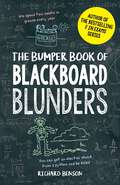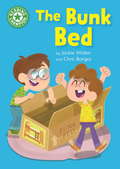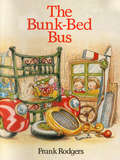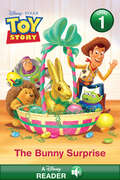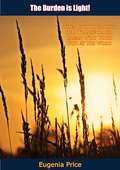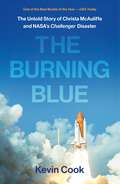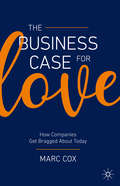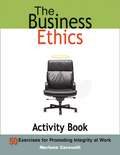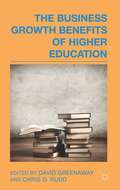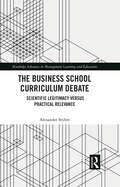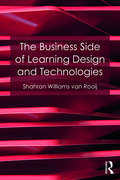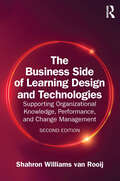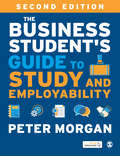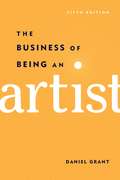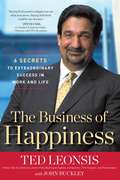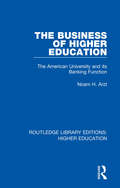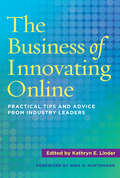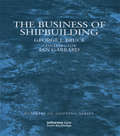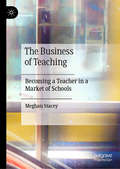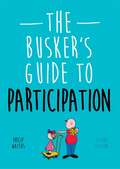- Table View
- List View
The Bullying Antidote
by Kristen Caven Louise HartThis big-picture look at bullying by community psychologist Dr. Louise Hart and her co-author, Kristen Caven (other books include The Winning Family and On the Wings of Self-Esteem), takes on the challenge of correcting the common and widespread parenting practices that contribute to today's bullying epidemic.Drawing from psychological, medical, sociological, educational, and neurological research, they build a theory of bullying that spans across communities and generations, one that will ring a bell for most parents. The book teaches hundreds of specific, positive practices to turn the next generation of children into richly developed, healthy adolescents and adults who possess what the authors lightly label "ZORGOS," the superpower that defeats bullying. The overall intent is not just to stop a single bullying incident, but to develop immunity in today's children to future bullying events. The Bullying Antidote shows how parents and community leaders, by becoming educated about the mechanics of power dynamics and prevention, can build bully-free, emotionally safe families, neighborhoods, and communities.Some of the things parents will learn in this book:1. Parenting styles that can either nurture or interrupt bullying behaviors2. Three ways parents with good intentions unknowingly raise bullies3. What bullying is and what it is not4. What to do when your child is bullied, bullies, or witnesses bullying5. How to build a child's core strengths and competencies6. How assertive communication is non-violent communication7. How nurture and structure balance family life and emotions8. How to build your authority without being a dictator9. Ten ways to build resilience10. How to use technology positively at all agesThe authors provide an online resource for readers of this book. Search zorgos.wordpress for links, notes, a discussion guide and an author interview.
The Bumper Book of Blackboard Blunders: Spelling Slip-Ups and Homework Howlers
by Richard Benson'I need to work hard on my maths so I will be god at it.''My dads boss lives in a big hose.''When I am older I want to learn to drive a cat.' Children are at their funniest when they’re trying to be serious, and their earnest attempts at mastering the English language are a goldmine of unintentional humour, from the charming to the ludicrous, and from the profound to the downright X-rated. Enjoy this bumper edition of side-splitting spelling slip-ups and hilarious homework howlers.
The Bunk Bed: Independent Reading Green 5 (Reading Champion #112)
by Jackie WalterIn this story, Freddie and Billy are getting bunk beds. They are very excited but just cannot agree on which bunk each should have. Luckily, Mum has a plan.Reading Champion offers independent reading books for children to practise and reinforce their developing reading skills.Fantastic, original stories are accompanied by engaging artwork and a reading activity. Each book has been carefully graded so that it can be matched to a child's reading ability, encouraging reading for pleasure.Independent Reading Green stories are perfect for children aged 4+ who are reading at book band 5 (Green) in classroom reading lessons.
The Bunk-Bed Bus
by Frank RodgersIncluded in the the original Standard Attainment Tests book list for English schoolsJanet and Sam have the most dynamic granny you’ve ever met. She goes jogging, builds shelves and fixes cars - and when a snooty neighbour tells her she’s not artistic she’s determined to prove her wrong. Granny sets to work and creates a wonderful iron sculpture for the art exhibition. The local children think it’s great - but what will the judges think of the amazing bunk-bed bus?Just perfect for beginner readers.
The Bunny Surprise (Toy Story)
by Disney PressBuzz Lightyear, Sheriff Woody, and the rest of the toys from Disney/Pixar Toy Story are back for an Easter adventure! Kids ages 4-6 will love learning to read with this Step 1 Step into Reading reader.
The Burden is Light!: The Autobiography of a Transformed Pagan Who Took God at His Word
by Eugenia PriceA successful novelist and writer recounts the events that led her to become a born again Christian, and describes the ways her faith has sustained her.—Print ed.
The Burning Blue: The Untold Story of Christa McAuliffe and NASA's Challenger Disaster
by Kevin CookThe untold story of a national trauma—NASA’s Challenger explosion—and what really happened to America’s Teacher in Space, illuminating the tragic cost of humanity setting its sight on the starsYou’ve seen the pictures. You know what happened. Or do you?On January 28, 1986, NASA’s space shuttle Challenger exploded after blasting off from Cape Canaveral. Christa McAuliffe, America’s “Teacher in Space,” was instantly killed, along with the other six members of the mission. At least that's what most of us remember.Kevin Cook tells us what really happened on that ill-fated, unforgettable day. He traces the pressures—leading from NASA to the White House—that triggered the fatal order to launch on an ice-cold Florida morning. Cook takes readers inside the shuttle for the agonizing minutes after the explosion, which the astronauts did indeed survive. He uncovers the errors and corner-cutting that led an overconfident space agency to launch a crew that had no chance to escape.But this is more than a corrective to a now-dimming memory. Centering on McAuliffe, a charmingly down-to-earth civilian on the cusp of history, The Burning Blue animates a colorful cast of characters: a pair of red-hot flyers at the shuttle's controls, the second female and first Jewish astronaut, the second Black astronaut, and the first Asian American and Buddhist in space. Drawing vivid portraits of Christa and the astronauts, Cook makes readers forget the fate they're hurtling toward. With drama, immediacy, and shocking surprises, he reveals the human price the Challenger crew and America paid for politics, capital-P Progress, and the national dream of "reaching for the stars."
The Bus for Us
by Suzanne BloomA perfect picture book to share with children starting school or those riding the school bus for the first time. It&’s the first day of school for Tess, and it&’s also her very first ride on a school bus. Waiting at the bus stop with her older friend Gus, Tess eagerly asks, &“Is this the bus for us, Gus?&” as each vehicle passes by. Award-winning author and illustrator Suzanne Bloom introduces young readers to a diverse cast of characters and a variety of vehicles in this charming book that makes a great gift for any child about to start school.
The Business Case for Love: How Companies Get Bragged About Today
by Marc CoxLove it? Hate it? Or, just don’t care? How we feel about something dramatically affects how we interact with it. When we feel, we care. When we care, things happen. Companies that are thriving, not just surviving, are much more than a set of ruthlessly efficient and mechanistic processes – they are a social system operated by people for people. The quality of relationships, both inside and outside the organization is a far more important driver of sustainable success or failure than the quality of its control systems. The head is important, but it is the heart that matters most. If you want your customers to be brand ambassadors and your employees to brag about you to their friends, you need them to not just think you’re great – you need them to feel you’re great. You need them to love you – and for that, you need them to feel that you love them. For over a decade Marc Cox has been helping companies whose toxic cultures, miserable employees, and angry customers have all but destroyed them to rebuild their company spirit, discover the business case for love and build an organization that is wonderful to work for, brilliant to do business with and has the mindset of creating memorable employee and customer experiences. Underpinned by fresh insights and perspectives, robustly tested and refined by the real world experience of working with a wide range of companies and over 2,000 senior executives drawn from all parts of the world, and filled with fascinating and illustrative “love stories” the book will help you to make the business case for love. It will help you to find a more rewarding and invigorating way of working – both emotionally and financially. In short, it shows what happens when the love is put back into business.
The Business Ethics Activity Book: 50 Exercises for Promoting Integrity at Work
by Marlene Caroselli<P>In an age of ethical decay at organizations of every type, a call is being sounded for accountability.<P> Accordingly, companies must educate their employees and executives regarding acceptable practice. The Business Ethics Activity Book presents an array of provocative activities that will help encourage a more ethical approach to:* Leadership: promoting courage, commitment, and moral responsibility* Workplace conduct: building an ethical environment on individual behavior* Salesmanship: exploring the relationships between sellers and their customers* Management: leading employees by example in daily situations* Teamwork: fostering group behavior that reflects the company’s moral outlookEach section features an interview with a leading ethicist, and every activity provides step-by-step instructions. Also, discussion prompts and suggestions for variations enable the trainer or leader to expand each exercise’s application.<P> These exercises will push organizations to challenge the climate of questionable or unexamined ethics and recommit themselves to responsible business methods.
The Business Growth Benefits of Higher Education
by David Greenaway Chris D. RuddThis book tackles the role of universities in driving economic growth. Their role as providers of talent, technology and new ideas is considered in the light of the 2008 Global Financial Crisis. A series of expert authors consider success, opportunity and how national frameworks can be fine-tuned to deliver business success.
The Business School Curriculum Debate: Scientific Legitimacy versus Practical Relevance (Routledge Advances in Management Learning and Education)
by Alexander StyhreWith more than 14,000 business schools worldwide, what is included in their curricula matters for how the economy and the corporate system are managed. Business schools should be subject to scholarly inquiries and critical reflection. While many studies of business schools examine its general role in the tertiary education system and in society more broadly, this volume examines how one specific theoretical perspective and a normative model derived therefrom were developed and gradually appropriated within the business school setting. This volume demonstrates that agency theory, based on a daring conjecture that firms can be construed as bundles of contacts, rose to prominence in the business school context. It examines how the elementary proposition of agency theory, that the firm is to be considered theoretically and practically as a "nexus of contracts," was never consistent with corporate law and contract law, and it was empirically unsubstantiated. Business schools are under pressure to teach not only practically useful theories and models, but also theories that are also scientifically qualified. Despite having this ambition, certain theories are widely taught despite failing to live up to such declared ambitions, which means that business schools may be criticized for including theories on ambiguous grounds in the curricula. This book examines how business schools seek to honour the ambition to teach both scientifically verified theories and practically useful concepts and models, and how the tensions derived from this duality may be problematic to handle. It will be of interest to researchers, academics, and advanced students in the fields of management education, organizational studies, and legal theory.
The Business School in the Twenty-First Century
by Jagdish Sheth Peter Lorange Howard Thomas Howard Thomas Peter LorangeQuestions about the status, identity and legitimacy of business schools in the modern university system continue to stimulate debate amongst deans, educational policy makers and commentators. In this book, three world experts share their critical insights on management education and new business school models in the USA, Europe and Asia, on designing the business school of the future, and how to make it work. They look at how the business school is changing and focus in particular on emergent global challenges and innovations in curricula, professional roles, pedagogy, uses of technology and organisational delineations. Set within the context of a wider discussion about management as a profession, the authors provide a systematic, historical perspective, analysing major trends in business school models, and reviewing a wealth of current literature, to provide an informed and unique perspective that is firmly grounded in practical and experimental analysis.
The Business Side of Learning Design and Technologies
by Shahron Williams van RooijThe Business Side of Learning Design and Technologies provides a ready reference with actionable tools and techniques for recognizing the impact of learning design/technology decisions at the project, business unit, and organizational levels. Written for early- and mid-career learning designers and developers as well as students and researchers in instructional/learning design and technology programs, this volume focuses on the business issues underlying the selection, design, implementation, and evaluation of learning opportunities. Using scholarly and practitioner research, interviews with Learning and Development thought leaders, and the author’s own experience, readers will learn how to speak the language of business to demonstrate the value of learning design and technologies.
The Business Side of Learning Design and Technologies: Supporting Organizational Knowledge, Performance, and Change Management
by Shahron Williams van RooijThe Business Side of Learning Design and Technologies provides actionable tools and techniques for recognizing the impact of learning design/technology decisions at the project, business unit, and organizational levels. With a focus on aligning learning initiatives with organizational objectives, the book equips early- and mid-career learning designers with essential skills in applying business strategy, artificial intelligence, data analytics, and change management to the selection, design, implementation, and evaluation of learning opportunities. This thoroughly revised second edition further emphasizes the designer as change agent, addresses the rise of remote and hybrid workplaces, adds fresh perspectives on automated and generative systems, and updates its resources, references, and interviews. Grounded in scholarly and practitioner research, systematic literature reviews, interviews with learning and development thought leaders, and real-world experience, this book provides actionable strategies for career advancement in a dynamic labor market.
The Business Student′s Guide to Study and Employability
by Peter MorganWritten in response to the pressures on universities to produce highly skilled and work-ready graduates and intended to map across a three-year business course, this book covers essential skills, from study, presentation and leadership to practical advice on securing that all-important job after university. A number of hands-on learning aids feature throughout, including: Skills self-assessment tables, ′For You to Do′, Integration and Application, Interview questions. This second edition has been thoroughly updated, and is complemented by a companion website featuring a range of tools and resources for lecturers and students, including an Instructor’s Manual and PowerPoint slides, answers and guidance on skills assessment tasks, templates and examples to download as well as additional online chapters on topics such as testing, assessment and alternative options for graduates. Suitable for all students taking a business degree.
The Business Student′s Guide to Study and Employability
by Peter MorganWritten in response to the pressures on universities to produce highly skilled and work-ready graduates and intended to map across a three-year business course, this book covers essential skills, from study, presentation and leadership to practical advice on securing that all-important job after university. A number of hands-on learning aids feature throughout, including: Skills self-assessment tables, ′For You to Do′, Integration and Application, Interview questions. This second edition has been thoroughly updated, and is complemented by a companion website featuring a range of tools and resources for lecturers and students, including an Instructor’s Manual and PowerPoint slides, answers and guidance on skills assessment tasks, templates and examples to download as well as additional online chapters on topics such as testing, assessment and alternative options for graduates. Suitable for all students taking a business degree.
The Business of Being an Artist
by Daniel GrantThe fifth edition of this updated and expanded classic provides visual artists with an in-depth guide to developing and building a career as a professional artist. Veteran art writer Daniel Grant weaves the words and experiences of dozens of practicing artists throughout this informative volume to describe their real-life challenges and the solutions they found to overcome them. Grant covers everything from art gallery etiquette to the legal rights of artists, including chapters on: Making the transition from school to the working world Searching for funding through grants and fellowships Developing relationships with art dealers Handling criticism and rejection How to stay safe in the studio Finding a variety of ways to get paid in the new economy New to this edition are expanded sections that look at utilizing exhibition venues from sidewalk fairs to regional biennials to national parks, selling in other countries, talking with collectors about your art and yourself, avoiding the perils of defamation, transporting and travelling with art, using "greener” materials, and the experience of becoming an artist later in life and of artists’ children. The Business of Being an Artist is an invaluable resource for art students, aspiring artists, and professional artists who want to learn all there is to know about successfully navigating the world of art.
The Business of Education: Networks of Power and Wealth in America (Sociocultural, Political, and Historical Studies in Education)
by Joel Spring Corie A. Mccallum Diane Price Banks John Eric FranksonThe Business of Education—a comprehensive view of how education policy is made in the US and, in some cases, globally—analyzes and critiques the influence of educational policy networks in a wide range of contexts and from a variety of perspectives, including testing, college preparation, juvenile detention centers, special education, the arts, teacher evaluation systems, education of undocumented immigrants, college faculty preparation, and financial aid. A network chart in most chapters illustrates how the major political actors, mainly private philanthropic foundations, for-profit companies, government officials, and politicians involved in the network, are linked. Joel Spring, internationally renowned scholar and analyst of educational policy, situates and frames the network studies in an introduction discussing general theories of education policy networks.
The Business of Happiness: 6 Secrets to Extraordinary Success in Life and Work
by Ted Leonsis John BuckleyWhat's Your Plan For Happiness?When the plane he was on prepared for a crash landing, Ted Leonsis asked himself the crucial question, If today is my last day on earth-will I die happy?. . . and realized the answer was no. Despite having achieved massive business success-he was a self-made multi-millionaire at the age of twenty-seven-he realized he would die unfulfilled. He told God that if he survived, he would turn his life around, give back more than he took, and pursue happiness. After walking off that plane, he got to work.In The Business of Happiness, Ted Leonsis, owner of the Washington Capitals and former group president and vice chairman of AOL, shares the six secrets of happiness he discovered since that fateful plane ride. Treating happiness as a goal like any other, he made a list of what he thought would make him happy, and made a plan to achieve his goals. Along the way he discovered an incredible truth-business or financial success doesn't bring happiness, but happiness can bring you business and financial success.Inside The Business of Happiness, you'll learn, as Ted did:* How success follows happiness (not the other way around)* The importance of having a "double bottom line"-and how you really can do well by doing good* The key to finding your own higher calling* Why you should have a life plan for happiness, just as an entrepreneur has a business plan to launch and sustain a business* The six essential secrets that lead to happiness and success* How Ted lived his journey from a Brooklyn kid to sports team franchise owner-and the lessons learned along* What was on Ted's list-and what should be on yoursNothing is more universal than the desire to be happy. Ted Leonsis has made a lifetime's study of that desire and how to achieve it-and now he wants to share what he's learned with you. The Business of Happiness will show you how to become the happy, successful, and generous person you've always wanted to be.
The Business of Higher Education: The American University and its Banking Function (Routledge Library Editions: Higher Education #1)
by Noam H. ArztOriginally published in 1995, The Business of Higher Education focuses on innovation in student financial services. It looks at the area of banking function as a tool for colleges and universities, and how this can be used to meet the market demand for new services. It also addresses how this can be used to balance the financial aid budget. The book documents just how much each colleges and universities have changed over the last decade and how each has changed given that market forces increasingly shape institutional aspirations.
The Business of Innovating Online: Practical Tips and Advice From Industry Leaders
by Kathryn E. LinderThe Business of Innovating Online responds to a critical need for concrete narratives of innovation success that can serve as a foundation for administrators and leaders who are in need of practical guidance as they scale and grow their online learning organizations.Through specific examples and practical suggestions from experienced e-learning leaders, readers will be introduced to concrete strategies for how to create a climate of creativity and innovation that can lead to more successful and scalable online programs and initiatives. The Business of Innovating Online demystifies the relationship between business, creativity, and innovation by describing the logistics required to create an agile online education enterprise. Topics discussed will include:- Defining innovation and creativity for online education and e-learning- Knowing when and how to innovate- Creating a culture of innovation- Effectively leading innovation- Collaborative innovation- Making innovation stick and transitioning innovative strategies into day-to-day practice- Assuring quality in the midst of innovation- Staffing structures/administrative stability to support creativity and innovationThe Business of Innovating Online provides both novice and experienced online education administrators with a comprehensive overview of a range of online innovations, how they came to be created, the components that led to their success, and concrete steps that they can take to create a more innovative culture for their own e-learning organization.
The Business of Shipbuilding
by George Bruce Ian GarrardThe Business of Shipbuilding thoroughly analyses vessel construction, from material receipt and preparation, to final outfitting. It explains the central role of computer technology in the design process, the growing importance of supply chain management for materials and services and the use of subcontractors. Methods of measuring progress, productivity, performance and the need for enforcing standards during construction are also discussed. Through the use of practical examples, The Business of Shipbuilding explains the structure of shipbuilding in Japan, Korea, the European Union, China, Eastern Europe and the Americas and places this in the context of the economic and political climate of each region. Written in a clear and concise style and illustrated throughout with diagrams, charts and plans, The Business of Shipbuilding will be an invaluable reference tool both for experienced shipbuilders and for shipowners, managers, operators, brokers, insurers, lawyers, universities, surveyors and equipment suppliers.
The Business of Teaching: Becoming a Teacher in a Market of Schools
by Meghan StaceyThis book explores the experiences of early career teachers in a profession that has become highly stratified by market processes. The author presents New South Wales, Australia as a case study: a state with a long history of academically selective and private sector schooling, which has become increasingly segregated under a series of neoliberalised policy reforms since the 1980s. The experiences of teachers in this book are rich and varied, from a variety of different contexts – ranging from public schools enrolling students experiencing significant educational disadvantage to elite independent schools serving much more advantaged student cohorts. Highlighting teachers’ experiences in themselves rather than their impact on students, this timely book will be of interest and value to scholars of sociology of education, teachers’ work and education policy.
The Busker's Guide to Participation, Second Edition
by Chris Bennett Philip Waters"Participation? Of course we do - every Wednesday without fail..." · What is participation? · What's the difference between 'adult-led' and 'child-led' participation? · And do we really need to do it at all? This second edition of The Busker's Guide to Participation sets out to help us understand our values and reasons for undertaking participation with children and young people. It shows us what authentic participation really looks like, helping us to get to grips with the ways we can positively support, interact, engage, include, involve and communicate with children and young people on all levels. Learn how to move away from simply 'doing' participation for participation's sake, and start to see participation as a 'way of being' for the benefit of everyone involved.
